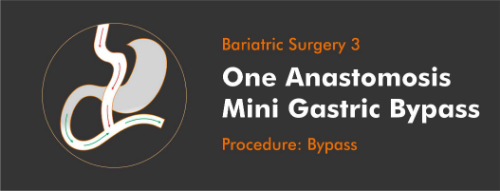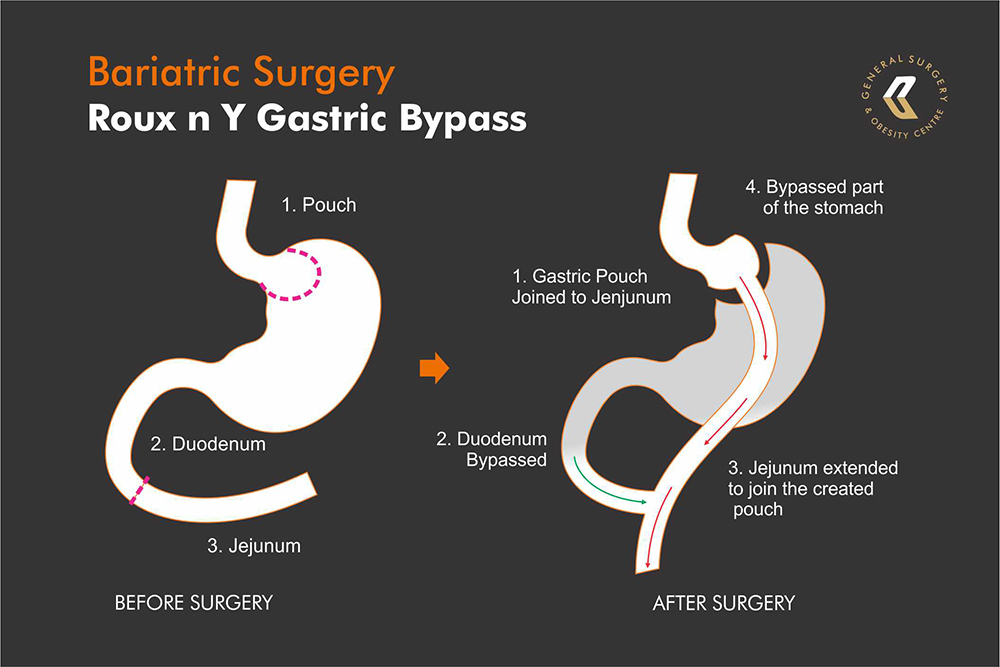
What is it One Anastomosis Bypass Surgery?
Also know as
Mini Gastric Bypass (MGB)
Single Anastomosis Gastric Bypass (SAGB)
Background of One Anastomosis Bypass or Minis Gastric Bypass
The Mini Gastric Bypass was first practiced by Mason and Ito in 1967. In 1997 Dr R Rutledge modified the procedure and named it Mini Gastric Bypass. In 2022 Drs Cabarjo and Caballero improved the technique by preventing bile reflux. This became known as One Anastomosis. Since then the procedure has increased in popularity.
One Anastomosis Gastric Bypass (MGB-OAGB) is a bariatric weight loss surgical procedure which has gained popularity, accounting for up to 1.5% of surgeries performed across the globe.
The American Society of Metabolic and Bariatric Surgery states that 228 000 procedures were performed in 2017.
Who is a suitable candidate for One Anastomosis Bypass?
In order for patients to be considered for One Anastomosis Bypass, patients should have a Body Mass Index (BMI) of above 35
Patients who suffer from obesity-related conditions such as
- Sleep apnea
- Fatty liver disease
- Type 2 diabetes
- Hypertension
- Severe Acid Reflux or GERD
- Slower Metabolism
- “Sweet Tooth”
- Barrett’s Esophagus
- Eating Disorders such as Bulimia or Binge eating
How much weight can I lose with One Anastomosis Bypass?
Weight loss averages 65% for most patients with over 85% of patients losing and maintaining 50% initial excess weight loss.

How is the One Anastomosis performed?
A laparoscopic telescope with a camera and instruments are used to perform the procedure. This allows the surgeon access to the stomach.
An anastomosis is an artificial connection made by a surgeon
The One Anastomosis Bypass procedure is performed at three stages
1. The gastric pouch, which is the remaining modified and resized stomach. A narrower pouch.
2. Connecting the resized stomach to the small intestine, medically known as a Gastrojejunostomy procedure.
3. And the Limb lengthening
The surgeon then lifts a part of the small intestine up to the newly created pouch and attaches it, a gastrojejunostomy.
What are the benefits of One Anastomosis Bypass?
- Shorter operating times due to its laparoscopic nature
- Weight loss expectancy of between 65-85%
- Reduction of conditions associated with obesity such as, type 2 diabetes, fatty liver disease, sleep apnea and other morbid conditions are greatly reduced
- Essential hypertension is relieved in over 70% of patients,
- Lower-back pain and joint pain are typically relieved or improved in nearly all patients,
- Leg swelling are typically alleviated
What to expect after One Anastomosis?
This is usually individualized based onthe surgery and the patient. Most patients require pain medication for one week following surgery.
It may be advised to avoid intercourse, baths, douching, strenuous exercise or heavy lifting for 4-6 weeks after the operation.
One Anastomosis Mini Gastric Bypass normal recovery times
Most people stay in the hospital for 2 to 3 days. Most patients can return to work within five to seven days and get back to normal activities in 3 to 5 weeks.
Walking exercises and raising the legs when seated are important. These light activities will reduce the chance of blood clots.
One Anastomosis lifestyle changes
Lifestyle changes are an important part of post operative recovery.
Bariatric surgery improves your physical quality of life as you become more flexible. It will help you
- regain independence,
- improve breathing,
- increase energy and stamina,
- and relieve joint pain caused by obesity.
Exercise will become faster and easier as the excess weight is lost, build stamina and discover cardiovascular fitness.
One Anastomosis Post Treatment Meals
Dietary requirements for the first few days after the operation will include fluids such as small sips of water, low calorie drinks and sugar free juices.
Individuals must avoid malnutrition after a gastrectomy by eating sufficient protein every day.
Patients should take supplements, vitamins and minerals to avoid deficiencies. Supplements should either be in a liquid, under-the-tongue or a chewable form right after surgery
Risk factors One Anastomosis
Any surgery performed under general anesthesia carries certain risks. Although small, there is a 5-10% that these risks can occur These may include
- heavy bleeding
- infection
- blood clots formed in the legs
- side effects of anesthesia
- lung or breathing problems.
Risks associated with One Anastomosis Bypass
- Leakage represent the most common complication
- Bleeding is the second most common risk factor, this occurs at the stapled lining along the gastric pouch
- Dumping syndrome,when food is consumed too quickly, this can be be corrected through an correct eating habits
- Blood clots
- Nausea
- Serious acid reflux
- Dilation of esophagus.
- Inability to eat certain foods.
- Obstruction of the stomach.
Are you a suitable candidate for Weight Loss Surgery
find out now
